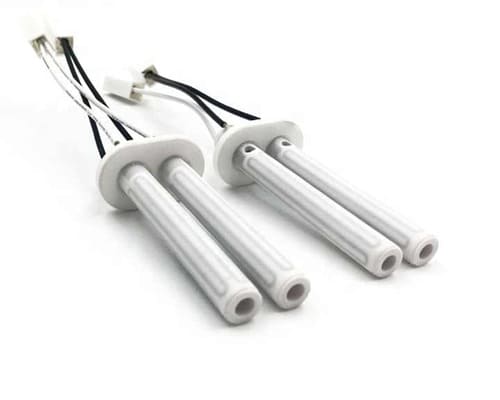Ceramic Heating Elements Last 3X Longer Than Metal
When it comes to selecting heating elements, ceramic heating elements stand out for their remarkable durability and longer lifespan, making them the preferred choice in many high-temperature applications. Compared to traditional metal heating elements, ceramic heating elements can last up to three times longer, which has led to their widespread use in industries, household appliances, and the automotive sector. This article will explore why ceramic heating elements outperform metal heating elements in terms of durability and analyze the benefits they offer in various applications. By comparing the characteristics of ceramic and metal heating elements, we will reveal why ceramics excel in long-term performance.
At Advanced Ceramics Hub, we specialize in high-quality ceramic heaters that ensure optimal performance for industrial and scientific applications.

What Are Ceramic Heating Elements?
Ceramic heating elements are devices that convert electrical energy into heat, with their core made from ceramic materials. These heating elements leverage the excellent insulating and high-temperature resistant properties of ceramic materials to provide stable heating effects. Ceramic heating elements typically work based on the principle of electrical resistance heating, where electric current passes through the ceramic material to generate heat, which then heats the surrounding air or objects. Compared to metal heating elements, ceramic heating elements have a longer lifespan, higher thermal efficiency, and greater durability.
Common applications:
- Industrial: Used in furnaces, kilns, and semiconductor manufacturing for precise, high-temperature heating (e.g., wafer processing at 500–1200°C).
- Automotive: Employed in glow plugs, cabin heaters, and battery thermal management for electric vehicles.
- Medical: Utilized in sterilization equipment and imaging systems for consistent, reliable heating.
- Aerospace: Applied in component testing and high-temperature environments, leveraging ceramics’ durability.
| Ceramic Material | Key Properties | Max Temperature (°C) | Typical Applications | Industry Examples |
| AlN (Aluminum Nitride) | High thermal conductivity (170–320 W/m·K), excellent thermal shock resistance | 1000–1200 | Semiconductor wafer processing, precision heating | Industrial furnaces, kilns, and household heaters |
| Al2O3 (Aluminum Oxide) | Cost-effective, durable, moderate thermal conductivity (20–30 W/m·K) | 1600–1800 | Industrial furnaces, kilns, household heaters | Industrial, household appliances |
| SiC (Silicon Carbide) | High thermal conductivity (100–150 W/m·K), corrosion resistance | 1400–1600 | Chemical processing, high-temp furnaces | Industrial, chemical processing |
| Si3N4 (Silicon Nitride) | High strength, good thermal shock resistance, moderate conductivity (15–40 W/m·K) | 1200–1400 | High-strength applications, engine components | Aerospace, automotive |
| PBN (Pyrolytic Boron Nitride) | High purity, thermal stability, moderate conductivity (30–60 W/m·K) | 1800–2000 | Vacuum furnaces, high-purity semiconductor processes | Semiconductor, aerospace |
Looking for premium ceramic heaters? Explore Advanced Ceramics Hub’s selection.
What Are Metal Heating Elements?
Metal heating elements are components made of metals that convert electrical energy into heat through the process of electrical resistance. These elements are commonly used in a variety of heating applications due to their ability to withstand high temperatures, conduct electricity efficiently, and maintain durability.
Common Types:
- Nichrome (Nickel-Chromium) Heating Elements: Made from nickel-chromium alloy, commonly used in toastters, hair dryers, and industrial furnaces due to their ability to withstand temperatures up to 1200℃.
- Kanthal (Iron-Chromium-Aluminum) Heating Elements: Composed of iron, chromium, and aluminum, widely used in industrial kilns, ovens, and high-temperature furnaces, capable of operating up to 1400℃.
- Stainless Steel Heating Elements: Constructed from stainless steel alloys, used in water heaters, boilers, and food processing equipment, typically for moderate temperatures (up to 700°C).
- Incoloy Heating Elements: A nickel-iron-chromium alloy with superior corrosion resistance, especially in harsh environments, common in immersion heaters, chemical processing, and marine applications, handling temperatures up to 900°C.
- Tungsten Heating Elements: Made from tungsten, known for extremely high melting points (up to 3400°C), used in specialized applications like vacuum furnaces, semiconductor processing, and high-temperature testing.
- Molybdenum Heating Elements: Constructed from molybdenum, offering high strength and heat resistance up to 1900°C, found in high-temperature furnaces, glass melting, and aerospace applications.
- Copper Heating Elements: Made from copper, valued for excellent thermal conductivity but limited to lower temperatures (up to 600°C), used in low-temperature applications like domestic water heaters.
Why Ceramic Heating Elements Last Longer
Ceramic heating elements are renowned for their exceptional durability, often lasting up to three times longer than metal heating elements in high-temperature applications. This extended lifespan is driven by several key material properties: high heat resistance and thermal stability, superior corrosion resistance, lower thermal expansion coefficients compared to metals, and a low oxidation rate that minimizes material degradation. These characteristics make ceramics like Aluminum Nitride (AlN), Aluminum Oxide (Al2O3), and Pyrolytic Boron Nitride (PBN) ideal for demanding environments such as semiconductor manufacturing, industrial furnaces, and aerospace.
Ceramics’ High Heat Resistance and Thermal Stability:
Ceramics can withstand extreme temperatures (up to 2000°C for PBN) without deforming or losing structural integrity, unlike metals, which typically degrade above 1200°C. Their thermal stability ensures consistent performance under prolonged high-temperature exposure, reducing wear and extending lifespan.
- Ceramics maintain structural integrity at temperatures up to 2000°C.
- Materials like Al2O3 and PBN resist thermal fatigue, unlike metals.
- Stable performance minimizes downtime in industrial applications.
Ceramics’ Corrosion Resistance:
Ceramics are highly resistant to chemical corrosion, making them suitable for harsh environments like chemical processing or vacuum systems. Unlike metals, which corrode or rust when exposed to chemicals or moisture, ceramics like SiC and PBN maintain their integrity, significantly extending service life.
- Ceramics resist acids, alkalis, and other corrosive agents.
- Ideal for vacuum and cleanroom environments (e.g., semiconductor manufacturing).
- Metal heaters corrode, leading to frequent replacements.
Differences in Thermal Expansion Coefficient Between Ceramics and Metals:
Ceramics have lower thermal expansion coefficients (e.g., 4–8 x 10⁻⁶/°C for Al2O3) compared to metals (e.g., 10–17 x 10⁻⁶/°C for stainless steel), meaning they expand and contract less with temperature changes. This reduces mechanical stress, cracking, and warping, contributing to a longer lifespan.
- Lower thermal expansion reduces stress and cracking risks.
- Ceramics maintain shape under thermal cycling, unlike metals.
- Enhanced durability in applications with frequent temperature changes.
Low Oxidation Rate of Ceramics, Reducing Material Degradation:
Ceramics exhibit minimal oxidation even at high temperatures, unlike metals, which form oxide layers that degrade performance and lead to failure. Materials like AlN and PBN have low oxidation rates, ensuring long-term stability and reducing the need for frequent replacements.
- Ceramics resist oxide formation, maintaining performance.
- Metals oxidize rapidly, leading to scaling and material loss.
- Low oxidation extends ceramic heater lifespan to 5–15 years.
Comparison Table:
| Property | Ceramic Heating Elements | Metal Heating Elements |
| Max Temperature (°C) | 1000–2000 (e.g., PBN: 2000°C) | 600–1200 (e.g., Nichrome: 1200°C) |
| Thermal Stability | High (resists thermal fatigue) | Moderate (prone to thermal fatigue) |
| Corrosion Resistance | High (resists acids, alkalis, vacuum) | Low (prone to rust, chemical degradation) |
| Thermal Expansion Coefficient (x 10⁻⁶/°C) | 4–8 (e.g., Al2O3: 7.5) | 10–17 (e.g., Stainless Steel: 15) |
| Oxidation Rate | Low (minimal oxide formation) | High (rapid oxide layer formation) |
| Lifespan (Years) | 5–15 (e.g., Al2O3: 10 years in furnaces) | 1–5 (e.g., Nichrome: 3 years in furnaces) |
Request a custom quote for ceramic heaters.
Applications Benefiting from Ceramic Heater Longevity
The extended lifespan of ceramic heating elements, often lasting 5–15 years compared to 1–5 years for metal heaters, delivers substantial value across various industries. Their durability, high heat resistance (up to 2000°C), and corrosion resistance make them ideal for demanding applications where reliability and minimal downtime are critical. Industries such as semiconductor manufacturing, aerospace, industrial processes, and medical equipment benefit significantly from ceramic heaters’ longevity, reducing maintenance costs and enhancing operational efficiency. This section explores these applications, highlighting how ceramic heaters’ long lifespan translates into practical advantages for each sector.
Semiconductor Manufacturing:
In semiconductor manufacturing, ceramic heaters provide precise and uniform heating for processes like wafer fabrication, operating in cleanroom environments where purity and reliability are paramount. Materials like Aluminum Nitride (AlN) and Pyrolytic Boron Nitride (PBN) ensure consistent performance over 10–15 years, minimizing costly downtime and replacements.
- AlN and PBN offer high thermal conductivity (170–320 W/m·K) for precise heating.
- Long lifespan (10–15 years) ensures reliability in 500–1200°C cleanroom processes.
- Reduced maintenance lowers costs in high-value semiconductor production.
Aerospace:
Aerospace applications require heaters that withstand extreme temperatures (1000–1600°C) for testing components like turbine blades or engine parts. Ceramic heaters, made from Aluminum Oxide (Al2O3) or Silicon Carbide (SiC), offer high-temperature stability and durability, lasting up to 10 years and reducing replacement costs in rigorous testing environments.
- Al2O3 and SiC maintain stability at high temperatures, ideal for aerospace testing.
- A lifespan of 8–10 years minimizes disruptions in component validation.
- Corrosion resistance ensures reliability in harsh testing conditions.
Industrial Processes:
Industrial furnaces and kilns, used in metal processing or ceramics production, operate at high temperatures (800–1800°C) and require robust heating solutions. Ceramic heaters, particularly Al2O3 and SiC, last 5–12 years, reducing downtime and maintenance costs in continuous, high-demand operations.
- Al2O3 and SiC withstand thermal shock and corrosion, ideal for furnaces.
- Long lifespan (5–12 years) reduces operational interruptions.
- Cost-effective for high-throughput industrial processes.
Medical Equipment:
Medical equipment, such as sterilization systems and imaging devices, relies on ceramic heaters for consistent, safe heating at moderate temperatures (200–800°C). AlN and Al2O3 heaters provide reliability over 8–15 years, ensuring uninterrupted operation in critical healthcare applications where safety is non-negotiable.
- AlN and Al2O3 ensure uniform heating for sterilization and imaging.
- Lifespan of 8–15 years supports long-term reliability in medical settings.
- Corrosion resistance prevents degradation in humid or chemical environments.
| Industry | Application Example | Material Preference | Temperature Range (°C) | Lifespan (Years) | Key Benefit |
| Semiconductor Manufacturing | Wafer processing | AlN, PBN | 500–1200 | 10–15 | Precision, minimal downtime |
| Aerospace | Engine component testing | Al2O3, SiC | 1000–1600 | 8–10 | High-temp stability, cost savings |
| Industrial Processes | Furnaces, kilns | Al2O3, SiC | 800–1800 | 5–12 | Reduced downtime, durability |
| Medical Equipment | Sterilization, imaging systems | AlN, Al2O3 | 200–800 | 8–15 | Long-term reliability, safety |
In conclusion, ceramic heating elements stand out for their superior durability compared to metal heating elements due to their high heat resistance, excellent thermal stability, corrosion resistance, low oxidation rates, and favorable thermal expansion properties. These factors make ceramics the ideal choice for high-temperature applications where longevity and reliability are essential.
When choosing between ceramic and metal heating elements, the decision should be based on the specific requirements of the application. For environments with extreme temperatures, corrosive substances, or where long-term durability is critical, ceramic heating elements are the optimal choice. On the other hand, metal elements may be more suitable for lower-cost, less demanding applications with moderate temperature requirements.
The future of ceramic heating elements appears promising, with advancements in materials science paving the way for even higher-performance ceramics. As technology continues to evolve, ceramic heating elements are likely to play a pivotal role in a wide range of industries, from industrial manufacturing to energy-efficient home appliances.
Looking for premium ceramic heaters? Contact us today!
